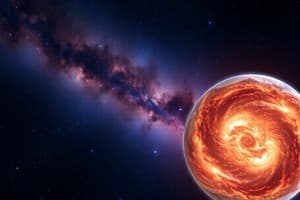Podcast
Questions and Answers
What is the name of the hypothesis that suggests planets were formed out of a cloud of material associated with a youthful sun?
What is the name of the hypothesis that suggests planets were formed out of a cloud of material associated with a youthful sun?
- Galactic Hypothesis
- Nebular Hypothesis (correct)
- Stellar Hypothesis
- Cosmic Hypothesis
Who revised Immanuel Kant's hypothesis in 1796?
Who revised Immanuel Kant's hypothesis in 1796?
- Carl Weizascar (correct)
- Isaac Newton
- Otto Schmidt
- Albert Einstein
What did the solar nebula surrounding the sun mostly contain?
What did the solar nebula surrounding the sun mostly contain?
- Carbon and Nitrogen
- Hydrogen and Helium (correct)
- Helium and Lithium
- Oxygen and Nitrogen
Which two scientists proposed a revised version of the 'nebular hypothesis' in 1950?
Which two scientists proposed a revised version of the 'nebular hypothesis' in 1950?
What process led to the formation of a disk-shaped cloud according to the text?
What process led to the formation of a disk-shaped cloud according to the text?
Which philosopher initially proposed a large number of hypotheses regarding the origin of the Earth?
Which philosopher initially proposed a large number of hypotheses regarding the origin of the Earth?
When did the process of photosynthesis evolve?
When did the process of photosynthesis evolve?
Where was life confined to for a long time?
Where was life confined to for a long time?
What began to flood the atmosphere 2,000 million years ago?
What began to flood the atmosphere 2,000 million years ago?
How do modern scientists refer to the origin of life?
How do modern scientists refer to the origin of life?
Where is the record of life that existed on this planet found?
Where is the record of life that existed on this planet found?
What is the most popular argument regarding the origin of the universe?
What is the most popular argument regarding the origin of the universe?
According to Edwin Hubble's evidence, what did he observe about the universe?
According to Edwin Hubble's evidence, what did he observe about the universe?
What does the expanding universe hypothesis suggest according to the text?
What does the expanding universe hypothesis suggest according to the text?
At what temperature did atomic matter first begin to form in the universe according to the text?
At what temperature did atomic matter first begin to form in the universe according to the text?
What concept did Fred Hoyle propose as an alternative to the Big Bang Theory?
What concept did Fred Hoyle propose as an alternative to the Big Bang Theory?
What process gives rise to the formation of stars within a galaxy?
What process gives rise to the formation of stars within a galaxy?
What is believed to have taken place around 5-6 billion years ago according to the text?
What is believed to have taken place around 5-6 billion years ago according to the text?
What are planetesimals according to the text?
What are planetesimals according to the text?
What causes larger bodies to form in the early stages of planet development?
What causes larger bodies to form in the early stages of planet development?
What did Edwin Hubble observe about galaxies as time passes?
What did Edwin Hubble observe about galaxies as time passes?
During the formation of the Earth, which material moved towards the surface due to differences in density?
During the formation of the Earth, which material moved towards the surface due to differences in density?
What is the outermost layer of the Earth's structure called?
What is the outermost layer of the Earth's structure called?
How old are the Earth's oceans believed to be?
How old are the Earth's oceans believed to be?
What is the main contributor to the present composition of Earth's atmosphere?
What is the main contributor to the present composition of Earth's atmosphere?
How did the Earth's atmosphere evolve according to the text?
How did the Earth's atmosphere evolve according to the text?
What process led to the formation of the Earth's oceans?
What process led to the formation of the Earth's oceans?
What was the early atmosphere of Earth primarily composed of?
What was the early atmosphere of Earth primarily composed of?
What initiated the process of evolution of the present atmosphere?
What initiated the process of evolution of the present atmosphere?
What allowed heavier materials like iron to sink towards the center of the Earth during its initial stages?
What allowed heavier materials like iron to sink towards the center of the Earth during its initial stages?
Which part of Earth's structure has the highest density material?
Which part of Earth's structure has the highest density material?
What is believed to be the initial trigger for the evolution of life on Earth?
What is believed to be the initial trigger for the evolution of life on Earth?
Where can the record of life that existed on Earth in different periods be found?
Where can the record of life that existed on Earth in different periods be found?
What event is believed to have taken place around 3,800 million years ago?
What event is believed to have taken place around 3,800 million years ago?
When did oxygen start to flood the Earth's atmosphere, according to the text?
When did oxygen start to flood the Earth's atmosphere, according to the text?
What enabled inanimate matter to be converted into living substance according to modern scientists referenced in the text?
What enabled inanimate matter to be converted into living substance according to modern scientists referenced in the text?
Where were structures closely related to the present form of blue algae found in geological formations?
Where were structures closely related to the present form of blue algae found in geological formations?
What is the name of the hypothesis proposed by Immanuel Kant and revised by Laplace in 1796 regarding the origin of the planets?
What is the name of the hypothesis proposed by Immanuel Kant and revised by Laplace in 1796 regarding the origin of the planets?
Who were the scientists that somewhat revised the 'nebular hypothesis' in 1950, differing in details from the original proposal?
Who were the scientists that somewhat revised the 'nebular hypothesis' in 1950, differing in details from the original proposal?
What did the 'nebular hypothesis' propose as the main composition of the solar nebula surrounding the youthful sun?
What did the 'nebular hypothesis' propose as the main composition of the solar nebula surrounding the youthful sun?
Which philosopher initially put forth a large number of hypotheses about the origin of the Earth before Immanuel Kant's proposition gained popularity?
Which philosopher initially put forth a large number of hypotheses about the origin of the Earth before Immanuel Kant's proposition gained popularity?
What was the process through which planets were believed to have formed according to the 'nebular hypothesis'?
What was the process through which planets were believed to have formed according to the 'nebular hypothesis'?
What is the name of the event that scientists believe took place 13.7 billion years before the present?
What is the name of the event that scientists believe took place 13.7 billion years before the present?
What did scientists observe about galaxies based on Edwin Hubble's evidence?
What did scientists observe about galaxies based on Edwin Hubble's evidence?
What did the alternative concept of Hoyle's steady state theory propose?
What did the alternative concept of Hoyle's steady state theory propose?
During the formation of galaxies, what initial density differences gave rise to gravitational forces?
During the formation of galaxies, what initial density differences gave rise to gravitational forces?
What is believed to have been converted into matter as the universe expanded?
What is believed to have been converted into matter as the universe expanded?
What was the initial form of all matter in the universe according to the Big Bang Theory?
What was the initial form of all matter in the universe according to the Big Bang Theory?
What is the main contributor to the development of galaxies during their formation?
What is the main contributor to the development of galaxies during their formation?
How did the formation of stars within a galaxy primarily occur?
How did the formation of stars within a galaxy primarily occur?
What process led to the formation of larger bodies in the early stages of planet development?
What process led to the formation of larger bodies in the early stages of planet development?
"Planetesimals" in planet formation are described as:
"Planetesimals" in planet formation are described as:
How did the earth evolve from a barren, rocky, and hot object into a beautiful planet with ample water and conducive atmosphere?
How did the earth evolve from a barren, rocky, and hot object into a beautiful planet with ample water and conducive atmosphere?
What is the main contributor to the present composition of Earth's atmosphere?
What is the main contributor to the present composition of Earth's atmosphere?
How old are the Earth's oceans believed to be?
How old are the Earth's oceans believed to be?
What process led to the evolution of Earth's atmosphere?
What process led to the evolution of Earth's atmosphere?
What was the early Earth's atmosphere primarily composed of?
What was the early Earth's atmosphere primarily composed of?
What allowed iron and other heavy materials to sink towards the center of the Earth during its initial stages?
What allowed iron and other heavy materials to sink towards the center of the Earth during its initial stages?
How did the Earth's oceans form?
How did the Earth's oceans form?
'Evolution of Atmosphere and Hydrosphere' discusses three stages in the evolution of the present atmosphere. Which one contributed to the modification of the atmosphere through photosynthesis?
'Evolution of Atmosphere and Hydrosphere' discusses three stages in the evolution of the present atmosphere. Which one contributed to the modification of the atmosphere through photosynthesis?
What was instrumental in the development of Earth's layered structure?
What was instrumental in the development of Earth's layered structure?
Flashcards are hidden until you start studying




